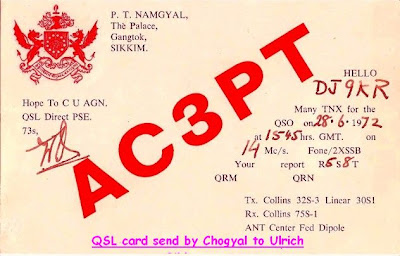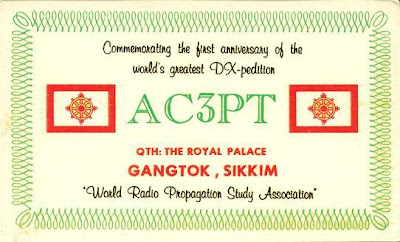
To the amateur radio stations in the world, he was just “AC3PT”, a name that is today counted as a deleted or dead country in the pages of Ham Radio. A "Ham" is an Amateur who receives and transmits on short waves, a fascinating hobby followed since the late 18th century.
An amateur radio enthusiast AC3PT was very well-known among amateur radio communicators across the world. Being on the map of HAM Radio since 1963, AC3PT suddenly came to an abrupt end on April 9, 1975. “…now Indian troops storming my room…” was the last message that radio amateurs across the world last heard of AC3PT. The distressed caller was none other than Chogyal Palden Thondup Namgyal, the last Chogyal of Sikkim State sending his last-minute SOS across the world.
When I first read about the AC3PT and the ham radio sometime back in one of the chapters of a much sought-after merger book on Sikkim “Smash and Grab: Annexation of Sikkim” by Sunanda K Datta-Ray I could hardly materialize what in the world is this ‘ham radio’?
Very little is known about amateur radio in Sikkim, so when I first surf around the web pages the very first person I came across was Ulrich Bihlmayer, a wonderful gentleman in his late sixties from Tuebingen, Germany. I am very pleased to say that it was “ Uli“ (as he wanted me to call him) who made me understand the distinct world of Hams. A known name among Ham radio users Uli has his call sign DJ9KR.
To the readers in Sikkim, it is of importance that Uli was one of the few fortunate radio amateurs to have exchanged words with the late Chogyal Palden Thondup Namgyal. In his own words, Uli describes- “ He had two radio contacts with AC3PT, in June 1972 and in August 1974, each time on 20 meters SSB. He remembers well that the Chogyal spoke English which was difficult to understand. He had an accent like Chinese people have.”
Along with him is a QSL card (a confirmation card radio hams use to confirm a two-way radio contact) sent by the Chogyal along with a personal letter attached dealing with the events of India’s hold upon his palace, much later after Sikkim State got included into India. I am thankful for Uli when he emailed me a scan of the QSL card and the personal letter sent by late Chogyal.
In Uli’s words, Amateur Radio is some 100 years old, and the first radio transmitters at that time were working on long waves. They needed very strong transmitters to catch a faraway place. These transmitters were used by Government and by Army/Navy/Air force and by broadcast.
People then (100 years ago) thought that the Short Wave spectrum was worth nothing and not to use, they gave this spectrum to radio amateurs. These amateurs soon found out that on Short Wave one could span large distances with very low power. So, like this, Amateur Radio on Short Waves was "Invented".
All amateurs must pass the examination in order to get the license of a radio operator. In India, the Ministry of Communication organizes the examination. Amateur radio stations have a range that depends upon the power radiated, the frequency used, and the modes of operations.
Every licensed ham receives a call sign which is their personal form of identification on the authorized radio bands of frequencies allotted for amateur operations by International agreement. The call sign normally consists of five letters. For example AC3PT, i.e. “AC3” stands for Sikkim and “PT” specifies the person; in this case, it was Palden Thondup.

The emails and the voice chats through Skype I exchanged with Uli were more than a wonderful experience. The topic I discussed with Uli is less heard in this part of the region even when it is known that it was through this wonderful wireless instrument the entire world came to know about the political unrest of the Sikkim State then.
Ever since AC3PT suddenly disappeared, the name of Sikkim too went off the records of the Ham Radio. Today Sikkim is part of the mighty Indian Union but to the world of Hams, AC3PT is a highly recognized name but a deleted country.
I was introduced to Horst Geerken, a German radio amateur who was one of the few to receive the emergency call of the Chogyal on April 9, 1975, equally with his (deceased) friend Hans Mauder, DL6FF, who was then residing in Jakarta. The distress call of the Chogyal was received in various countries at the same time. Geerken along with another Swedish ham listener immediately passed the news to a newspaper agency.
So, the next day the "hold up" was in all newspapers of the world. Certainly, the Indian troops had forgotten that the Chogyal owned amateur radio equipment. Later the Indian troops confiscated the equipment because the Chogyal did not have an official transmitting license, said Uli recalling those days.
Horst Geerken YB0AAG / DJ2JB, a German Engineer for Telecommunications for many years was in Jakarta, Indonesia, and worked as a Director for the German firm "Telefunken" in Jakarta headquarters. For some years Horst had returned to Germany owning the new call DJ4SM living in Bonn, in Rhineland, Germany.
Horst calls back the situation in his memory -“I was sitting at my radio station in Jakarta and suddenly heard the distress call of AC3PT. Our QSO with AC3PT took some 8 to 10 minutes and ended abruptly with his shrieky voice “now Indian troops storming my room…”. Our QSO was heard by two Swedish hams, Thomas Schell, SM6AFH, and Stig Pärsson, SM4JPN.
They called me on the radio after my radio contact with the Chogyal. We checked the name and address of AC3PT, and Thomas informed a Swedish journalist of the hold-up. Then I had a QSO with OM Horning, who lives near Hannover, northern Germany. He recorded my report on tape and sent it to Norddeutscher Rundfunk (North German Broadcasting) and to different news agencies. So the news about the hold up in Sikkim was spread very quickly over the whole world.”
The introduction of Amateur Radio to the furthest regions of Sikkim towards the early 60s was never easygoing. It was the handy hard work of late Gus Browning, W4BPD, amateur radio maniac. To Gus goes the credit for introducing Sikkim to the world of Amateur Radio. Gus was interested in activating countries that had never been heard of before, in this task he had just arrived from Bhutan when he met the Chogyal in Sikkim, and in no time Gus was able to convince the King of Sikkim State.
As a result in September 1963, a call sign with AC3PT was made ‘activate’. Since Sikkim then did not have any license so the Prefix “AC3” that was allocated to the USA was used for Palden Thondup. “The Chogyal was so fascinated by the ham radio, that, after Gus had left the kingdom, he ordered a complete Collins-S-Line (Tx 32S-3, Rx 75S-1, LA 30S-1), going on to use the call sign AC3PT.”





Dear Shital,
ReplyDeleteYour valuable research work done on the Late Chogyal has been forwarded to me by VU2UR. I consider this as one of the most important works that I have ever come across on this subject. I am a HAM (VU3MDL). I lived in Sikkim from 2002 to 2004 at Rangpo being the Deputy General Manager of Sikkim Mining Corporation.I visited the place around the palace several times along with my family.My son studied in the Holy Cross School,Tadong.
Now I live in Nagpur. You can hear me on Sundays on 20M band.
You have added more value to our hobby.Many many thanks.
B.B.Mandal
Call Sign: VU3MDL
QTH: Nagpur
Dear Mandal Sir
ReplyDeleteThanks for your king comment. I am thankful, you liked the post.
Thanks
Shital
informative..
ReplyDeleteThe article on Ham Radio was informative. A QSL (Acknowledgement) Card from AC3PT was very sought after. But it is not always talking for pleasure that hams indulge in. There are examples galore in which hams have provided efficient communication during emergencies such as floods, earthquakes, storms and other calamities.
ReplyDeleteI operated a Ham station from Gangtok from 1979 to 1995 with a callsign VU2RVM (VU2 denotes India) using home brewed equipment. Later as a Club Station of National Institute of Amateur Radio I used Kenwood equipment. In 1986, I trained 20 Scouts and Guides and their instructors from Sikkim and many of them got their licences. Some of them used to operate my equipment for going on air. Sadly with the advent of the internet and mobile communication, Ham Radio is steadily taking a backseat. But in Sikkim there is still scope for Ham radio to be used as a alternate means of communication during disasters.
I’ll email you copies of my QSL card and the QSLs that I received from various foreign countries on you e-mail and also post a copy of my book “ABC of Amateur Radio and Citizen Band” which is widely referred to by aspiring Hams.
Thanks Rajesh Sir...for your valuable inputs in response to the Ham Radio in Sikkim. It would be an honour to share the qsl cards you had received as well as copies of the HAM book.
ReplyDeleteSir i appreciate your effort in publishing the Sikkim guide...it is a trade mark for anyone interested in Sikkim.
Please mail me at himalayanreview@yahoo.com
I had read ( in smash and grab , just as you ) about the chogyal sending a distress signal via radio but I culd nt wrap my head around it until now, thanx to ur article. Really commendable work. Hope u wuld come out again wid mre work on the Namgyal dynasty.
ReplyDeleteThanks Shital for this detailed report "The AC3PT: A story of the deleted country". Excellent work.
ReplyDeleteHorst Geerken has not read it!
I gave him your link:
http://sikhim.blogspot.com
He will be very pleased and certainly get in touch with you.
M. Paech
dear shital da, this article on AC3PT was very informative. I have been looking to read the book smash and grab since long. can you tell me where can I find this book. If you have a soft copy of this can you send it to me, I would really be thankful.
ReplyDelete